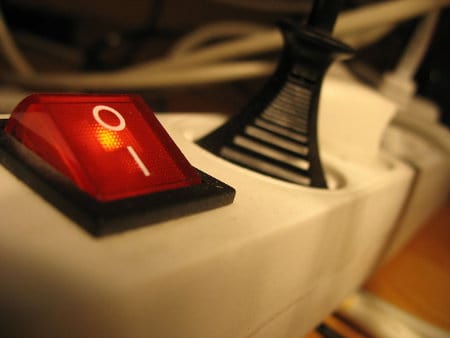Home Backup Generator Power Reduced by Vampire Loads

Many Devices Use Power All Day Long, Even When Turned Off
Once upon a time, when you turned something off, it was off. No little red or green or blue pinpricks of light—just a completely dark, completely unpowered room. Those little LEDs don’t use much power by themselves but shine a light on the energy use in your home. Devices that use electricity even while powered “Off” maintain some functionality whenever they are plugged in. Even a plugged-in phone still draws current when reaches full charge. These so called "Vampire Loads" are all around us and probably present in some form in every room of your house.
Vampire Loads add to your electricity bill. Maybe they don’t cost cost very much over the course of a month, but possibly more than you think. Even if don’t notice the difference on your utility bill, they may place enough additional load on a home backup generator to make it noticeable.
Why Do Some Devices Always Use Power?

There was a time when a television set or radio had to “warm up” before it worked. Alarm clocks were something you wound up and didn’t use any electricity at all. Now we have clock radios. The kitchen stove didn’t have a clock; microwaves were something only physicists understood. A cable box or DVR was nothing more than an errant thought or futuristic concept without a name.
Radios and televisions worked with tubes instead of silicon semiconductors. The tubes used a good portion of their electricity creating heat to work. Lean over an old tube-style television after an hour and the amount of heat coming from the back of would surprise many folks. Turning the on-off switch to “Off” meant opening a circuit and no electricity could flow. The device, whatever it was, used zero electricity when it was off.
Generac Guardian Home Backup Generators
Today, radios turn on instantly, and televisions may take half a second, unless we turn off the "instant on" feature. Many devices don’t have an off/on switch or knob and use a 1/0 button instead. Those buttons usually don’t disconnect the device from power. Instead, they shut down the circuits that power the main features and supply standby functionality instead. A television’s remote control remains functional even with the television turned off. Circuits inside the television use power and constantly watch for a signal from the remote. They use power for other functions too—smart TVs always stay connected to the internet.
Other devices use electricity constantly. Clock Radios require power to light the LED numerals. The microwave and kitchen range display LED clocks, as do coffeemakers and other devices. If you unplug your phone and leave the charger plugged into the wall socket, that charger still uses a small amount of power even though the phone isn’t plugged in.
Power Calculator: Add Up Power from Everyday Appliances
How Much Power do Always On Devices Use?
When you look at any one device, it does not use very much by itself. When you add it all up, however, the level of power use might surprise you. That power use can directly affect a standby generator that supplies power to your entire home, and it is always adding to your electric bill.
According to Alan Meier, a Senior Scientist at the Department of Energy, approximately 50 devices and appliances in the average home use power all day.
 Common "Vampire Load" Appliances
Common "Vampire Load" Appliances
- Cable DVR Box – 45 watts
- Cable Modem (Always on) – 15 watts
- Router (Always on) – 4 watts
- All-in-one stereo – 25 watts
- Television Audio Receiver – 20 watts
- Television – 20 watts
- Cell Phone / Tablet Charger (add them all up) – 1 watt.
- Cell Phone plugged into charger – 4 watts.
- Four Digit LED Clock Display (add them all up) – 1 -2 watts.
- Washing Machine with Electronic Controls – 6 watts.
Only considering these devices, including four cell phone or tablet chargers, plugged in but not connected to their device and two that are connected, adds up to almost 160 watts of power in use all day.
Briggs and Stratton Home Backup
From just these ten devices, we found 160 watts of power lost to constant energy use.
Laptops are surprising power hogs. A fully charged Apple Mac Book uses almost 30 watts of power if you leave it plugged in while open.
Many homes use much more depending on the age and type of appliances and devices they have. As the Internet of Things continues to grow, so do the devices that use power all day long. Usually, this isn’t a problem. Then a power outage hits and your standby generator starts up automatically. If you have 50 devices using an average of 10 watts of power each, that is 500 watts which can effectively reduce the available power from a standby generator by two to five percent.
Buyer Guide: How Much Generator Power Do I Need?
Managing Home Energy Use During Outages
 It’s not that hard to identify the constant energy use in your home, especially today. If it’s not a lamp or similar device with an actual on/off switch or knob, it probably uses energy whenever it is plugged in.
It’s not that hard to identify the constant energy use in your home, especially today. If it’s not a lamp or similar device with an actual on/off switch or knob, it probably uses energy whenever it is plugged in.
Power Strips make a good first line of defense. A few scattered around your home can help reduce power use. Just turn the strip off and the devices plugged into it no longer use power. Unplug other appliances and devices that use power when you don’t need them and only plug them in when you do.
Some things you might not want to unplug. What good is having a standby generator if you can’t watch the television or surf the internet for news about the outage? When the whole family is home on a hot day, and two air conditioners struggle to keep up, reducing loads might be a good idea. Alternatively, maybe you need a bigger generator. That’s one reason to thoroughly explore the power requirements of your home and family before making a purchase. Never buy the bare minimum. Always add ten to twenty-five percent to the total power needed for growing power use and unexpected or unplanned energy needs.
Sizing Guide for Home Standby Generators
Updated August 17, 2018
